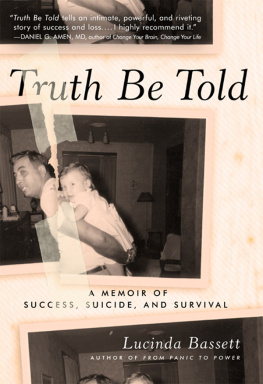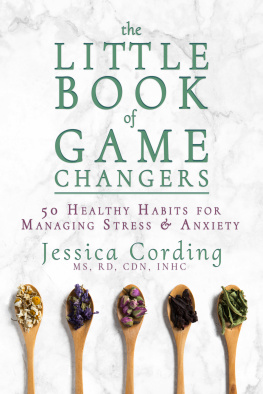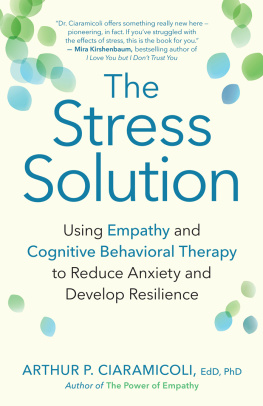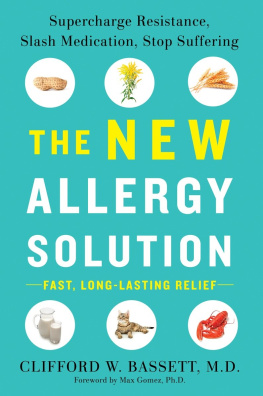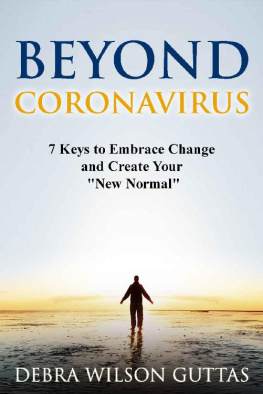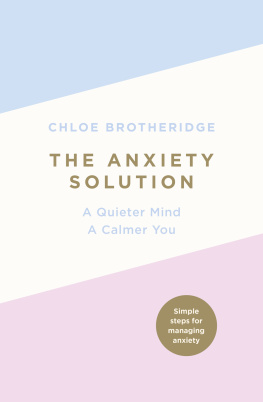THE
Solution
Conquer Your Fear, Control Your Future
Lucinda Bassett

STERLING and the distinctive Sterling logo are registered trademarks of
Sterling Publishing Co., Inc.
Library of Congress Cataloging-in-Publication Data Available
2 4 6 8 10 9 7 5 3 1
Published by Sterling Publishing Co., Inc.
387 Park Avenue South, New York, NY 10016
2011 by Midwest Center for Stress and Anxiety, LLC
Distributed in Canada by Sterling Publishing
c/o Canadian Manda Group, 165 Dufferin Street,
Toronto, Ontario, Canada M6K 3H6
Manufactured in the United States of America
All rights reserved
Sterling ISBN 9781402779886
For information about custom editions, special sales, premium and
corporate purchases, please contact Sterling Special Sales
Department at 8008055489 or specialsales@sterlingpublishing.com.
The Right to Happiness, from The Art of HappinessA Handbook for the Living by Dalai Lama and Howard C. Cutler, copyright 1998 by H H Dalai Lama and Howard C. Cutler. Used by permission of Riverhead Books, an imprint of Penguin Group (USA) Inc.
CONTENTS
by Daniel Amen, MD
by Lucinda Bassett
The Problem
The Solution
ACKNOWLEDGMENTS
DEDICATION
This book is dedicated to all the people
who have used my lifes skills
to improve their own.
You are why I continue to do what I do.

by Daniel Amen, MD
Author of Change Your Brain, Change Your Body
LUCINDA BASSETT HAS HELPED MILLIONS OF PEOPLE AROUND the globe conquer stress, anxiety, and depression. Her message has survived the test of time because it is relevant, extremely effective, and easy to understand and implement. Now, with her new book, The Solution, she continues to changes peoples lives for the better.
As a psychiatrist and brain enhancement expert, I started looking into Lucindas work a number of years ago because several of my patients had taken her home study course. I noticed quickly that she and I were aligned in our attitudes since she was teaching people many of the lessons that I had introduced to them in therapy. My research has shown me that learning effective mental health principles at home can be very effective in overcoming issues related to stress, anxiety, and depression. Clear focus, correcting negative thought patterns, eliminating self-limiting beliefs, learning how to manage anxiety and stress, and overcoming obstacles are keys to a healthy life, yet nowhere in school do we learn these essential tools. This is why Ms. Bassetts work is so valuable and crucial for finding happiness and fulfillment in our world today.
Given the challenging economy, the constant bombardment of negative media messages, the large number of two-parent working families, and countless other stresses, many people feel at the end of their rope. For these reasons, I love The Solution: Conquer Your Fear, Control Your Future because it is a road map to sanity and a healthy life. In this innovative book, Lucinda once again uses her talents as an expert in self-help and personal empowerment to teach people how to conquer their fears, worries, anxieties, and insecurities in order to create the life they want. The lessons, questionnaires, action assignments, and anecdotes are all geared toward recognizing what Lucinda calls your Core Story as she encourages people to use their inherent childhood weaknesses, challenging life experiences, and early trauma to create strength and power and increase their self-esteem.
In this book, Lucinda offers brand-new ways to embed these concepts into your mind. There is some insightful and creative work involved in the process, since all meaningful change requires effort. But if you persist, you are well on your way to a clearer mind, a healthier body, a more positive attitude, and an optimistic and clear perspective on your lifes potential. That really is what we all want.
RECENTLY I WAS IN A MARKETING MEETING EXPLAINING THE concept of this book, The Solution, to the creative team. They were expecting a two-minute elevator pitch, where I describe why my book is compelling, unique, and life-changing. Instead, I began by explaining the power and significance of the Core Story theory and re-active living.
We all have a Core Story, I began, and our life is all about how we react as a result of early programming and life experiences. Then I asked the people in the meeting a few questions:
How were you raised? What messages did you receive growing up, verbal and nonverbal? What did you see your parents doing? Were they worriers? Overreactors? Did anyone abandon you, scare you, or sabotage you? Did you go through anything youd prefer to deny or hide? What were the messages you received about money, responsibility, love, and relationships? How did your family members deal with stress, anxiety, and change?
I went on to explain that our Core Story is what molded each of us into who we have become. While genetics play a significant part, so does the environment along with all that we endured in our childhood and young adulthood, both good and bad. The point is, I told them, the way in which we handled these early challenges has shaped our current belief systems, which we have the power to change.
Our current beliefs that were programmed during childhood and adolescence have created automatic re-active attitudes and actions that determine how we spontaneously respond to everything from a stressful event to an anticipated concern, from an unhealthy relationship to a dissatisfying career. Because of these Core Story beliefs and the subsequent re-active responses that go with them, we may be making unproductive and even destructive choices. This book is about learning how to stop these negative behavioral cycles so we can feel better, have a happier, more successful life, and, more importantly, so we dont pass them on to our children.
One of the men in the meeting was so enthusiastic about the Core Story theory that he wanted to share part of his own Core Story with me. My mother had to drive for fifteen minutes over three bridges to get to the grocery store, he said. Then several years ago, the city erected a new bridge near her house that allowed her to cross just one bridge to get to the store, shortening her trip by at least ten minutes. But when I drove to the store with her, she took the old route. Why are you going this old way, I asked her, when the new route would save you time?
Well, Ive never gone that way, she said. What if I dont like it? This way is familiar and Id rather just stick to what I know. Never do something you havent done, Steven, because you may not like it.
Steven sat there shaking his head in disbelief. I understand why it was difficult for me to take risks and try new things in my life, he said. I wasnt a good risk-taker and now I know why.
Someone else shared a part of her Core Story, and then someone else did, too. Before I knew it, everyone understood at a profound level one of the most important concepts in this book:
Our Core Story made us who we are today, both bad and good.
And the good news is that we can use our Core Story to
positively transform our lives.
So how about you? Whats your Core Story? What is holding you back and keeping you stuck, justifying your misery, your lack, your fear or dysfunction? What past belief or experience is fueling your neediness, insecurity, or inability to take risks? Possibly you had a particularly challenging experience in your past that you would rather not remember, thinking nothing good could come from recalling such pain. But there is a purpose for the pain. You will come to understand why you struggled so much and what you are going to do with your pain by reading this book.
Next page

